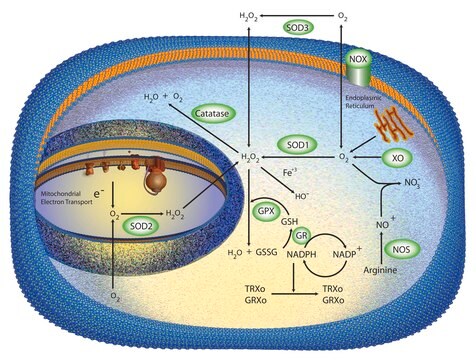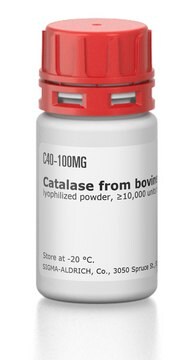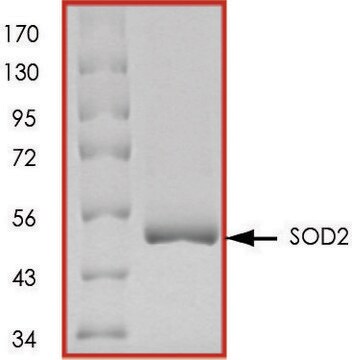Kluczowe dokumenty
S7571
Superoxide Dismutase from bovine erythrocytes
lyophilized powder, ≥3,000 units/mg protein, Protein ≥95 % by biuret
Synonim(y):
CU/ZN-SOD, Superoxide Dismutase 1 bovine, cytocuprein, erythrocuprein, hemocuprein, SOD, Superoxide: superoxide oxidoreductase
About This Item
Polecane produkty
pochodzenie biologiczne
bovine
Formularz
lyophilized powder
aktywność właściwa
≥3,000 units/mg protein
masa cząsteczkowa
32.5 kDa
skład
Protein, ≥95% biuret
warunki przechowywania
(Store under nitrogen.
Tightly closed. Dry.)
charakterystyka ekologicznej alternatywy
Atom Economy
Design for Energy Efficiency
Use of Renewable Feedstocks
Learn more about the Principles of Green Chemistry.
sustainability
Greener Alternative Product
metody
immunoblotting: suitable
inhibition assay: suitable
kolor
blue-green
pI
4.95
rozpuszczalność
water: 20 mg/mL
aqueous buffer, pH 7.5: soluble
Zastosowanie
diagnostic assay manufacturing
kategoria ekologicznej alternatywy
temp. przechowywania
−20°C
informacje o genach
cow ... SOD1(281495) , SOD2(281496)
Szukasz podobnych produktów? Odwiedź Przewodnik dotyczący porównywania produktów
Powiązane kategorie
Opis ogólny
Superoxide dismutase (SOD) is a redox-active metalloenzyme expressed in both aerobic and anaerobic living organisms. Bovine superoxide dismutase or CuZn SOD is a homodimer with each subunit containing one zinc and one copper ion.
Zastosowanie
- in a study to assess a kinetic model of radiation-induced inactivation of superoxide dismutase in nitrous oxide-saturated solutions
- in a study to investigate the possible participation of superoxide anion in the intestinal tryptophan 2,3-dioxygenase reaction
- to investigate its effect on the hemolysis rate of human RBCs and hemoglobin-nitric oxide complex (HbNO) stability in human erythrocytes
- in combination with catalase to study its effect on cell differentiation in vitro
- to quantify superoxide levels and study their effect on reactivity in mouse pulmonary arteries through chemiluminescence and cytochrome C reduction methods
Działania biochem./fizjol.
Definicja jednostki
Postać fizyczna
Zastosowanie
produkt powiązany
Hasło ostrzegawcze
Danger
Zwroty wskazujące rodzaj zagrożenia
Zwroty wskazujące środki ostrożności
Klasyfikacja zagrożeń
Resp. Sens. 1
Kod klasy składowania
11 - Combustible Solids
Klasa zagrożenia wodnego (WGK)
WGK 1
Temperatura zapłonu (°F)
Not applicable
Temperatura zapłonu (°C)
Not applicable
Środki ochrony indywidualnej
Eyeshields, Gloves, type N95 (US)
Wybierz jedną z najnowszych wersji:
Masz już ten produkt?
Dokumenty związane z niedawno zakupionymi produktami zostały zamieszczone w Bibliotece dokumentów.
Klienci oglądali również te produkty
Produkty
Oxidative stress is mediated, in part, by reactive oxygen species produced by multiple cellular processes and controlled by cellular antioxidant mechanisms such as enzymatic scavengers or antioxidant modulators. Free radicals, such as reactive oxygen species, cause cellular damage via cellular.
Protokoły
Enzymatic Assay of Superoxide Dismutase
Separation of Superoxide dismutase
Chromatograms
application for HPLCNasz zespół naukowców ma doświadczenie we wszystkich obszarach badań, w tym w naukach przyrodniczych, materiałoznawstwie, syntezie chemicznej, chromatografii, analityce i wielu innych dziedzinach.
Skontaktuj się z zespołem ds. pomocy technicznej










